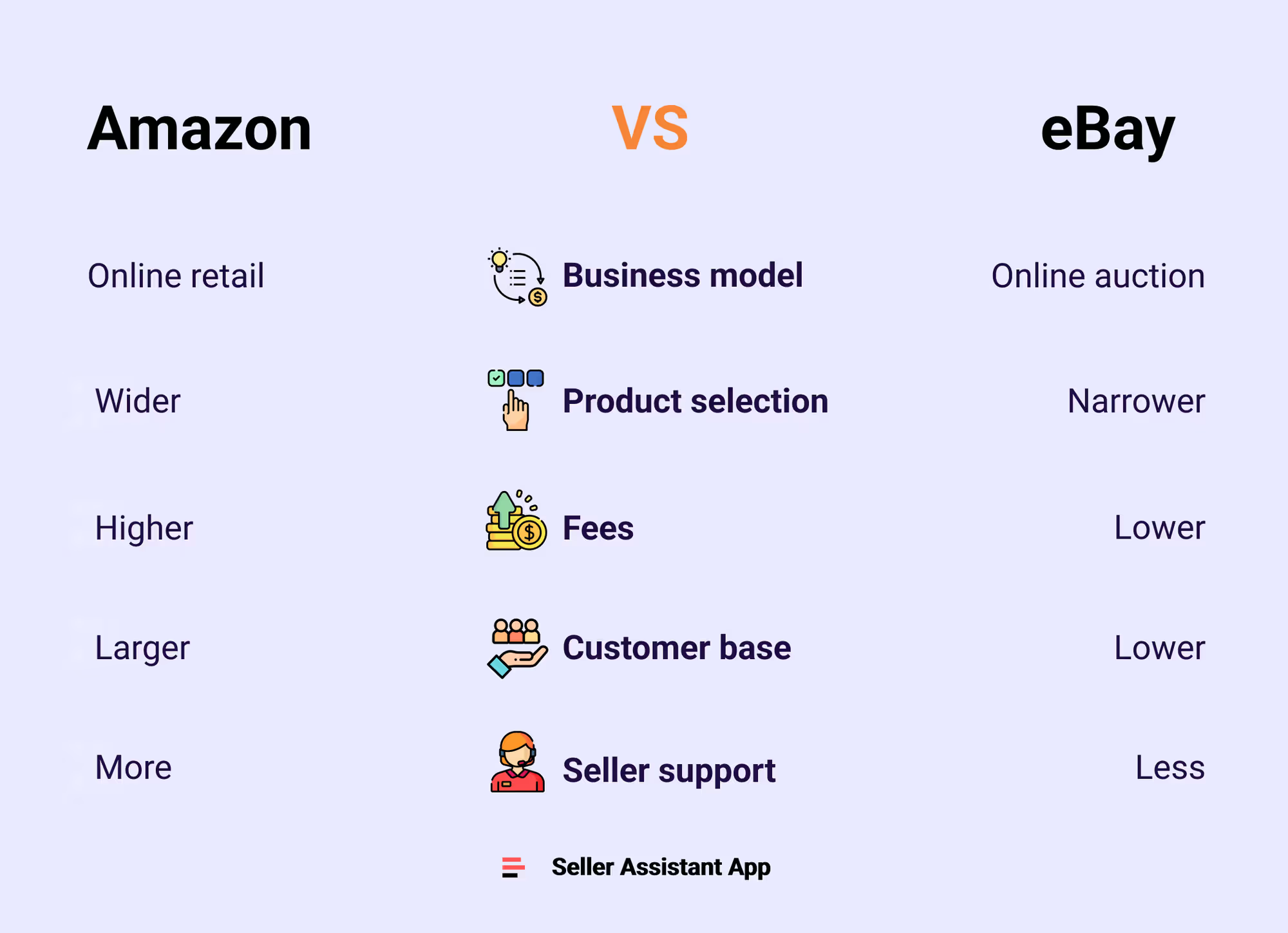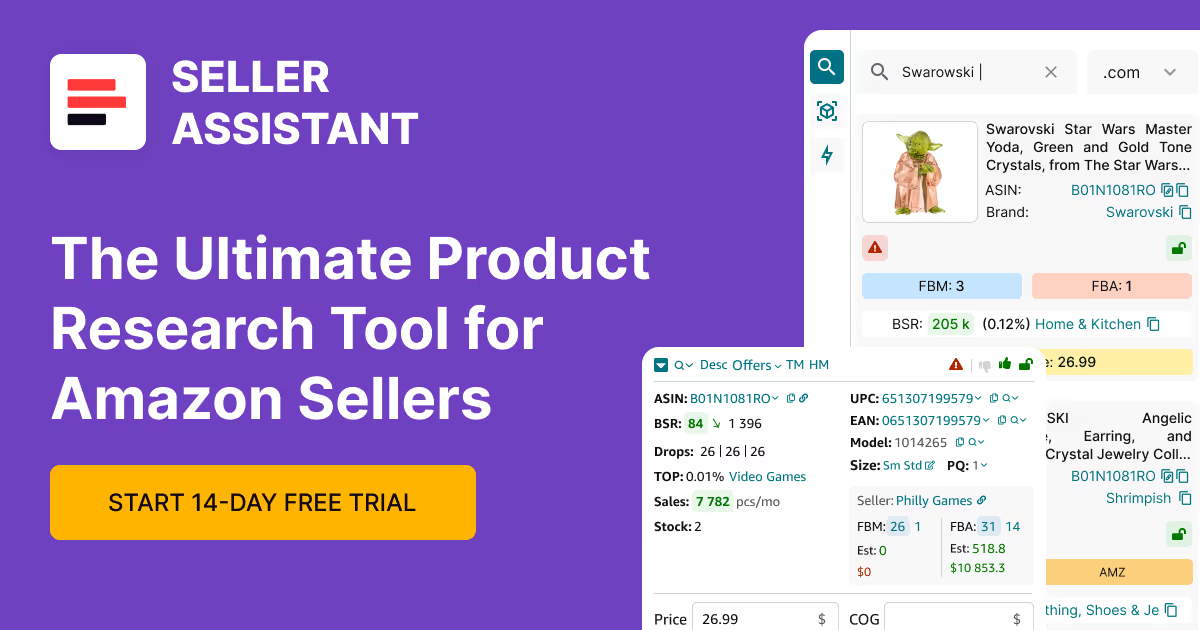Selling on Amazon vs. eBay: Which Is Better
Download Amazon Seller Guide
This guide will help you get started, understand the basics of Amazon selling, and explain in simple words how it all works.

Amazon and eBay are popular e-commerce platforms offering sellers excellent opportunities for making money. However, they have some differences, and the best platform for you will depend on your business needs and targets.
Amazon is the better choice if you're looking to reach a large audience and sell a wide variety of products. eBay may be a better fit if you're looking for lower fees and more control over your business.
In this post, we'll compare Amazon and eBay to help you decide which platform is right for you.
What Is the Difference between Amazon and eBay?
Amazon and eBay are e-commerce platforms popular among buyers and sellers across the world. They both offer sellers a way to reach a large audience of buyers, but there are some key differences between the two platforms.
Business model
Amazon is an online retailer that sells products directly to consumers. eBay is an online auction platform where sellers can either list their products for auction, and buyers bid on them or sell items for a fixed price.
Product selection
Amazon has a broader selection of products than eBay. That is because Amazon sells both the products that it stocks itself and the inventory that third-party sellers sell. eBay, on the other hand, only sells products that are listed by third-party sellers.
Fees
Amazon charges sellers higher fees than eBay. Amazon charges sellers per-item or account fees, referral fees per sale, and fulfillment fees if you use Amazon’s services to fulfill customer orders. eBay charges sellers a listing fee if you list more than 250 items monthly and a final value fee, but the fees are generally lower than Amazon's.
Customer base
Amazon has a more extensive customer base than eBay. It has more than 300 million active users worldwide. eBay has over 180 million active customers across the globe.
Seller support
Amazon offers more seller support than eBay. Amazon has a dedicated team of seller support representatives who can help sellers with a variety of issues, such as listing products, shipping items, and resolving disputes. eBay has a smaller team of seller support representatives who may be unable to help with as many issues.
Related: Seller Assistant App Extension Review
Seller Assistant App — the Ultimate Tool for Amazon Online Arbitrage

Pros and Cons of Selling on Amazon and eBay
Amazon and eBay can be great choice for sellers, but both have their upsides and downsides. You must be aware of them before you start selling.
Amazon pros
More potential customers
Amazon has a larger customer base than eBay, which means you have the potential to reach more buyers.
More brand awareness
Amazon is a more well-known brand than eBay, and buyers are more likely to trust you.
More buyer protection
Amazon offers more buyer protection than eBay, which is why buyers are less likely to file a dispute against you.
More opportunities for cross-selling and upselling
Amazon makes it easier to cross-sell and upsell products, which can help you increase your sales.
Amazon cons
Higher fees
Amazon's fees are generally higher than eBay's. The average Amazon referral fee is 15%, while eBay charges an average of 13% as the final value fee. Additionally, on eBay, you can create 250 free listings each month, while on Amazon, you pay either $0.99 per item sold as an individual seller or a monthly subscription fee of $39.99 as a professional seller.
More competition
Amazon has more competition than eBay, so standing out can be more challenging.
Stricter product restrictions
Amazon has stricter product restrictions than eBay, that’s why you may not be eligible to sell certain products.
More difficult to get started
It can be more difficult to get started on Amazon than on eBay. Amazon listings are more challenging to set up and manage.

eBay pros
Lower fees
eBay's fees are generally lower than Amazon's. On average, eBay’s final value fee is about 13%, while Amazon's referral fee is an average of 15%. Also, on eBay, you can create 250 free listings monthly, while on Amazon, there is a $0.99 fee per item sold or a monthly subscription fee of $39.99.
Less competition
eBay has less competition than Amazon, which means that it can be easier to sell.
Fewer product restrictions
eBay has fewer product restrictions than Amazon; therefore, you may be able to sell more products.
Easier to get started
It can be easier to get started and list your products on eBay than on Amazon.
More opportunities for haggling
eBay allows buyers to haggle on prices, which can help you sell your products for more money.
eBay cons
Less potential customers
eBay has a smaller customer base than Amazon, so you have the potential to reach fewer buyers.
Less brand awareness
eBay is not as well-known as Amazon, so buyers may be less likely to trust you.
Less buyer protection
eBay offers less buyer protection than Amazon, which means that buyers are more likely to file a dispute against you.
Fewer opportunities for cross-selling and upselling
eBay does not make it as easy to cross-sell and upsell products as Amazon.

What to Sell on Amazon and eBay?
There are many different products you can sell on Amazon and eBay. Some popular categories include Electronics, Clothing and Accessories, Home and Kitchen, Toys and Games, Books, Beauty, and Personal Care.
Amazon is an excellent place to sell new and popular products, brand-name products, and items with high profit margins. In turn, specific examples of products more commonly sold on eBay are unique or hard-to-find products, used products, and products with low profit margins.
How to select a product for Amazon and eBay?
The product you sell depends on your business goals and must meet your specific criteria. Below are some factors to consider when choosing products to sell on Amazon or eBay.
Restrictions
Amazon has stricter product restrictions than eBay, and they have many restricted categories. There are fewer product restrictions on eBay than on Amazon, and they are rather related to single products than entire categories. Therefore, you may sell more products on eBay.
Tip. You can quickly detect restricted products with Seller Assistant App. Seller Assistant App’s Restrictions Checker shows right on the product and search pages if you are eligible to sell the product and what type of restrictions it has.
Related: Seller Assistant App Extension Review

Demand
The product should be in demand and have a good resale value. Amazon has a larger customer base than eBay, so you have the potential to attract a bigger number of buyers. However, eBay has its own loyal customers and less competition, so it may be easier to reach them.
Tip. You can use product research tools like Seller Assistant App to estimate the product demand.

Competition
The product should not be too competitive, as this will make it difficult to sell. However, Amazon also has more competition, making it harder to stand out.
Tip. You can use Seller Assistant App to research competition for products. It shows the seller offer details and provides sales estimation if you become one more product seller.
Profitability
The product should be profitable after considering all the costs involved in selling it, such as product cost, shipping, and fees.
Seller Assistant App’s FBM&FBA Calculator helps accurately estimate an item’s profit, ROI, margin, fees, and shipping costs.

What Is Easier — Selling on Amazon or eBay?
Selling on Amazon and eBay can be both easy and challenging, depending on your specific circumstances and goals. Below are some factors to consider when deciding which platform is more accessible for you.
Ease of listing
eBay is quicker and less complicated when it comes to listing products, while Amazon is more sophisticated in creating listings. You must provide more information about your products, such as the condition, shipping options, and return policy.
Product restrictions
Amazon has stricter product restrictions than eBay, so you may have to do more research to ensure you can sell the products you want.
Fees
Amazon has higher fees than eBay, so you must factor this into your pricing.
Payments
It takes longer to get your money from sales on Amazon than on eBay. eBay transfers money to your PayPal account as soon as the product sells. Amazon transfers the money to your bank account 14 days after sales.
Amazon vs. eBay Selling Fees
Amazon and eBay charge sellers various fee categories. The total selling fees you pay will depend on the platform you use, the category of the items you sell, and your selling plan.
eBay fees
Insertion fees
On eBay, you can create 250 listings for free every month. For each listing created on top of that, you pay $0.35. This rule applies to auction and fixed-price listings.
Final value fees
These fees are a percentage of the item's final sale price, including shipping, handling, and sales tax. The fees depend on the category. On average, you pay 13.25% of the total sale amount below $7,500 items and 2.35% of the sale on $7,500 and up. Additionally, there is a fee of $0.30 per order.
Payment processing fees
eBay charges sellers for using the payment system. That is included in the final value fee.
Listing upgrade fees
Optional fees for adding features to your listing, such as bold font or a subtitle. That helps better showcase your listing for better visibility.

Amazon fees
Per-item or account fees
You can choose between two seller accounts: Individual and Professional. Individual sellers pay $0.99 per item sold, while Professional sellers pay a monthly subscription fee of $39.99.
Referral Fee
Amazon takes a percentage of the final sale price of each item sold, typically 15%.
Fulfillment by Amazon (FBA) fees
Amazon FBA fees are optional. They are charged for the services provided by Amazon to the sellers. FBA includes storing, picking, packing, shipping your products, and customer services. The fees vary depending on the weight and size of your products.
Inventory storage fees
These fees are also optional. Amazon charges monthly fees if you use FBA. These fees are paid for the space your inventory occupies in their fulfillment centers. The fees are calculated by your daily average volume in cubic feet.

Related: Amazon FBA Fees 2023
What Is Better — Selling on Amazon or eBay?
Whether selling on Amazon or eBay is better depends on your custom needs and goals. In addition to the pros and cons of the two platforms, below are a few factors to help you decide which one to choose.
Criteria to choose between Amazon and eBay
The products you want to sell
Some products are more popular on Amazon than on eBay, and vice versa. Amazon is better for selling popular and branded products, while eBay is a good place to sell collectibles and unique items because you can get a better price on an auction-type sale.
Your target audience
You must look into where your customers shop. If they are primarily on Amazon, then that's where you should sell. If you want to sell a collectible item, eBay may be a good fit.
Your budget
Amazon has higher fees, so eBay may be a better option if you are on a tight budget.
Your experience level
If you are new to selling online, eBay may be a better place to start. Amazon can be more complex, but it also offers more resources and support.
FAQ
Do you make more money on Amazon or eBay?
There are many factors that can affect your earnings, such as the products you sell, your target audience, and your marketing strategy. However, Amazon sellers generally tend to make more money than eBay sellers. That is because Amazon has a more extensive customer base and more buyer traffic.
Is it worth it to try and sell on Amazon?
Amazon is a large and competitive marketplace, but it also has a large customer base. If you can find a niche where you can compete, you can potentially make good money selling on Amazon. However, it is important to do your research and understand the platform before you get started.
Is it successful to sell on Amazon?
Yes, it is possible to be successful selling on Amazon. However, it takes hard work, dedication, and a good understanding of the platform. To succeed on Amazon, you must understand the platform, its fees, policies, and procedures, choose the right products, and set competitive prices. Seller Assistant App can help you find the right product.
Does selling on Amazon really work?
Selling on Amazon can be profitable, but success takes time and effort. If you are willing to put in the work and study Amazon fees and sales processes, learn to select the right products, and set competitive prices, it will work for you. Seller Assistant App can help you choose the winning products.
Final Thoughts
Selling on Amazon and eBay can both be profitable, but the best platform for you will depend on your business type and goals. Ultimately, the decision of which platform to use is up to you. You must carefully weigh each platform's pros and cons and decide which suits you best.
At the same time, your success largely depends on the product you sell, which must be a decisive factor in choosing where you will sell it. To find the winning product quickly, you can use product research tools.
Among such tools, the best choice in terms of price and quality is Seller Assistant Аpp. It helps you understand the product demand, profitability, and potential sales figures. It also alerts you if an item you selected has restrictions, IP complaints, and other issues and displays their nature. It aggregates an FBM&FBA profit calculator, Quick View, Stock Checker, and Restrictions Checker in one software.

.svg)













